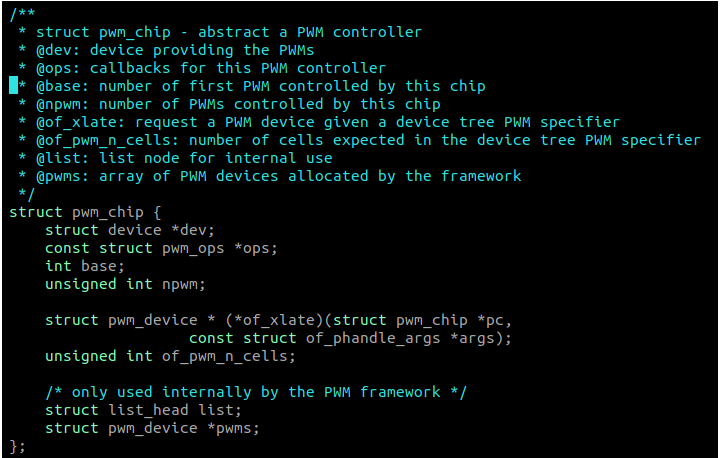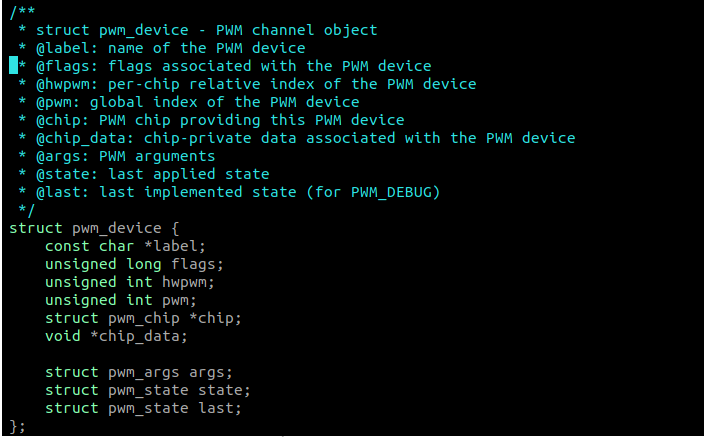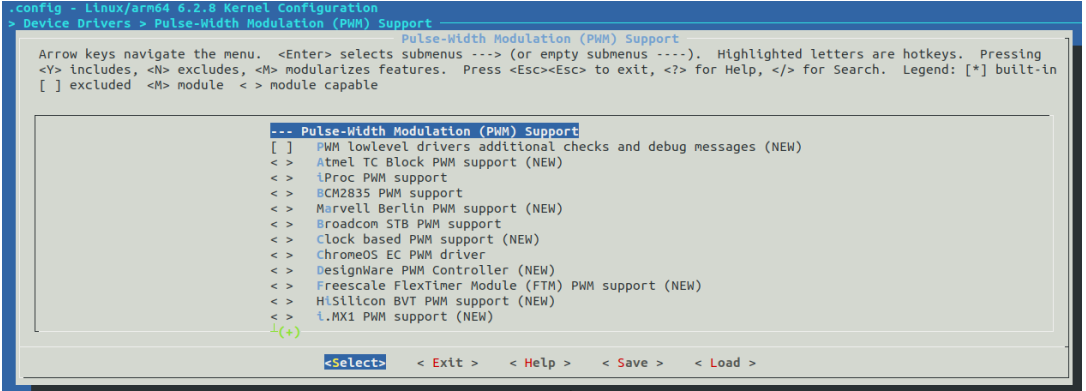Linux PWM driver
1 Overview
This article will provide an in-depth introduction to the PWM (Pulse-Width Modulation) driver framework of Linux, including its implementation principles, driver addition methods, and debugging methods to help developers better understand and use this function.
The example Linux kernel version shown in this article is 6.2.8.
2. Principle
PWM technology, as a commonly used modulation technology, can change the duty cycle of the effective signal by adjusting the high-level time width of the periodic waveform, thereby achieving power supply control for the device. Common PWM application areas include screen backlight brightness adjustment, motor speed control, and fan speed control. The Linux kernel supports the PWM driver framework and provides the PWM driver framework core code and sysfs interface code by abstracting the structure data types of the PWM controller and PWM signals. Developers can use this driver framework to easily add their own specific PWM controller drivers and use the sysfs interface for functional debugging.

Driver developers can design a dedicated PWM controller structure as needed, using the struct pwm_chip structure as a member variable. The following is an example, in the ./drivers/pwm/pwm-ab8500.c driver definition.

(2) struct pwm_ops structure, including the operation function of the PWM controller. The two basic functions that should be implemented by driver developers are the apply function and the get_state function; the apply function is used to configure the PWM controller, including configuring the enable state, period, duty cycle, polarity, etc. of the PWM signal; the get_state function is used Obtain the initial status of the specified PWM channel signal when registering the PWM controller, including enable status, period, duty cycle, polarity, etc.

(3) struct pwm_device structure, representing the PWM signal output by the PWM controller.

3.3 Driver Framework Core Function
(1) pwmchip_add function. Used to register a new PWM controller device. Defined in ./drivers/pwm/core.c.

(2) pwmchip_remove function. Used to remove a PWM controller device. Defined in ./drivers/pwm/core.c.

3.4 Driver typical implementation method
(1) Summary
The PWM driver source file is located in the ./drivers/pwm path. The driver developer needs to add the corresponding source file. The source file design can refer to the driver code of other manufacturers. Referring to the naming style of the original code, you can name the newly added driver source file pwm-xx.c, name the probe and remove functions as xx_pwm_probe and xx_pwm_remove respectively, and define the PWM controller structure as struct xx_pwm_chip. The files in the ./drivers/pwm path are as follows.

(2) apply function and get_state function definition
According to the PWM controller manual, the apply function and get_state function are defined by the driver developer.
(3)xx_pwm_probe function definition
The implementation method of the xx_pwm_probe function is: first initialize the PWM controller structure struct xx_pwm_chip variable, and then call the PWM driver framework core function pwmchip_add to register a new PWM controller device.
(4)xx_pwm_remove function definition
xx_pwm_remove function is implemented by calling the PWM driver framework core function pwmchip_remove to remove a PWM controller device.
4. Driver addition method
4.1 Add driver source file
Follow the method described in Section 3.4, write the driver source file pwm-xx.c, and add it to the ./drivers/pwm path.
4.2 Add compilation support
(1) Modify the Kconfig file under the ./drivers/pwm path and add the added PWM driver configuration options.
(2) Modify the Makefile file in the ./drivers/pwm path and add the compilation option of pwm-xx.c.
(3) In the memuconfig interface, enable the added PWM driver. The configuration interface is as follows.

4.3 Add PWM controller device tree node
Add the PWM controller device tree node in the device tree. The basic properties of this node include compatibility, registers and number of #pwm-cells. Add interrupts, clocks, resets and other properties as needed.
PWM controller device tree design method can refer to ./Documentation/devicetree/bindings/pwm.
The following is an example of a PWM controller device tree node. The reference documents are as follows:
./Documentation/devicetree/bindings/pwm/nvidia,tegra20-pwm.yaml.

5.Debugging method
Use the sysfs interface to perform functional debugging of the PWM driver. Examples of the main debugging commands are as follows.
(1) View PWM controller node
ls /sys/class/pwm/pwmchip0
(2) Open the specified PWM channel signal
echo n > /sys/class/pwm/pwmchip0/export
//n is the channel number
(3)Set the PWM signal period
echo pvalue > /sys/class/pwm/pwmchip0/pwm0/period
//pvalue is the period value
(4)Set the PWM signal duty cycle
echo dvalue > /sys/class/pwm/pwmchip0/pwm0/duty_cycle
//dvalue is the effective level width value
(5) Enable a certain PWM channel signal
echo 1 > /sys/class/pwm/pwmchip0/pwm0/enable
(6) Disable a certain PWM channel signal
echo 0 > /sys/class/pwm/pwmchip0/pwm0/enable
The above is the detailed content of Linux PWM driver. For more information, please follow other related articles on the PHP Chinese website!

Hot AI Tools

Undresser.AI Undress
AI-powered app for creating realistic nude photos

AI Clothes Remover
Online AI tool for removing clothes from photos.

Undress AI Tool
Undress images for free

Clothoff.io
AI clothes remover

Video Face Swap
Swap faces in any video effortlessly with our completely free AI face swap tool!

Hot Article

Hot Tools

Notepad++7.3.1
Easy-to-use and free code editor

SublimeText3 Chinese version
Chinese version, very easy to use

Zend Studio 13.0.1
Powerful PHP integrated development environment

Dreamweaver CS6
Visual web development tools

SublimeText3 Mac version
God-level code editing software (SublimeText3)

Hot Topics
 1661
1661
 14
14
 1417
1417
 52
52
 1311
1311
 25
25
 1261
1261
 29
29
 1234
1234
 24
24
 Linux Architecture: Unveiling the 5 Basic Components
Apr 20, 2025 am 12:04 AM
Linux Architecture: Unveiling the 5 Basic Components
Apr 20, 2025 am 12:04 AM
The five basic components of the Linux system are: 1. Kernel, 2. System library, 3. System utilities, 4. Graphical user interface, 5. Applications. The kernel manages hardware resources, the system library provides precompiled functions, system utilities are used for system management, the GUI provides visual interaction, and applications use these components to implement functions.
 How to check the warehouse address of git
Apr 17, 2025 pm 01:54 PM
How to check the warehouse address of git
Apr 17, 2025 pm 01:54 PM
To view the Git repository address, perform the following steps: 1. Open the command line and navigate to the repository directory; 2. Run the "git remote -v" command; 3. View the repository name in the output and its corresponding address.
 vscode Previous Next Shortcut Key
Apr 15, 2025 pm 10:51 PM
vscode Previous Next Shortcut Key
Apr 15, 2025 pm 10:51 PM
VS Code One-step/Next step shortcut key usage: One-step (backward): Windows/Linux: Ctrl ←; macOS: Cmd ←Next step (forward): Windows/Linux: Ctrl →; macOS: Cmd →
 What is the main purpose of Linux?
Apr 16, 2025 am 12:19 AM
What is the main purpose of Linux?
Apr 16, 2025 am 12:19 AM
The main uses of Linux include: 1. Server operating system, 2. Embedded system, 3. Desktop operating system, 4. Development and testing environment. Linux excels in these areas, providing stability, security and efficient development tools.
 How to run sublime after writing the code
Apr 16, 2025 am 08:51 AM
How to run sublime after writing the code
Apr 16, 2025 am 08:51 AM
There are six ways to run code in Sublime: through hotkeys, menus, build systems, command lines, set default build systems, and custom build commands, and run individual files/projects by right-clicking on projects/files. The build system availability depends on the installation of Sublime Text.
 How to run java code in notepad
Apr 16, 2025 pm 07:39 PM
How to run java code in notepad
Apr 16, 2025 pm 07:39 PM
Although Notepad cannot run Java code directly, it can be achieved by using other tools: using the command line compiler (javac) to generate a bytecode file (filename.class). Use the Java interpreter (java) to interpret bytecode, execute the code, and output the result.
 laravel installation code
Apr 18, 2025 pm 12:30 PM
laravel installation code
Apr 18, 2025 pm 12:30 PM
To install Laravel, follow these steps in sequence: Install Composer (for macOS/Linux and Windows) Install Laravel Installer Create a new project Start Service Access Application (URL: http://127.0.0.1:8000) Set up the database connection (if required)
 How to use VSCode
Apr 15, 2025 pm 11:21 PM
How to use VSCode
Apr 15, 2025 pm 11:21 PM
Visual Studio Code (VSCode) is a cross-platform, open source and free code editor developed by Microsoft. It is known for its lightweight, scalability and support for a wide range of programming languages. To install VSCode, please visit the official website to download and run the installer. When using VSCode, you can create new projects, edit code, debug code, navigate projects, expand VSCode, and manage settings. VSCode is available for Windows, macOS, and Linux, supports multiple programming languages and provides various extensions through Marketplace. Its advantages include lightweight, scalability, extensive language support, rich features and version




